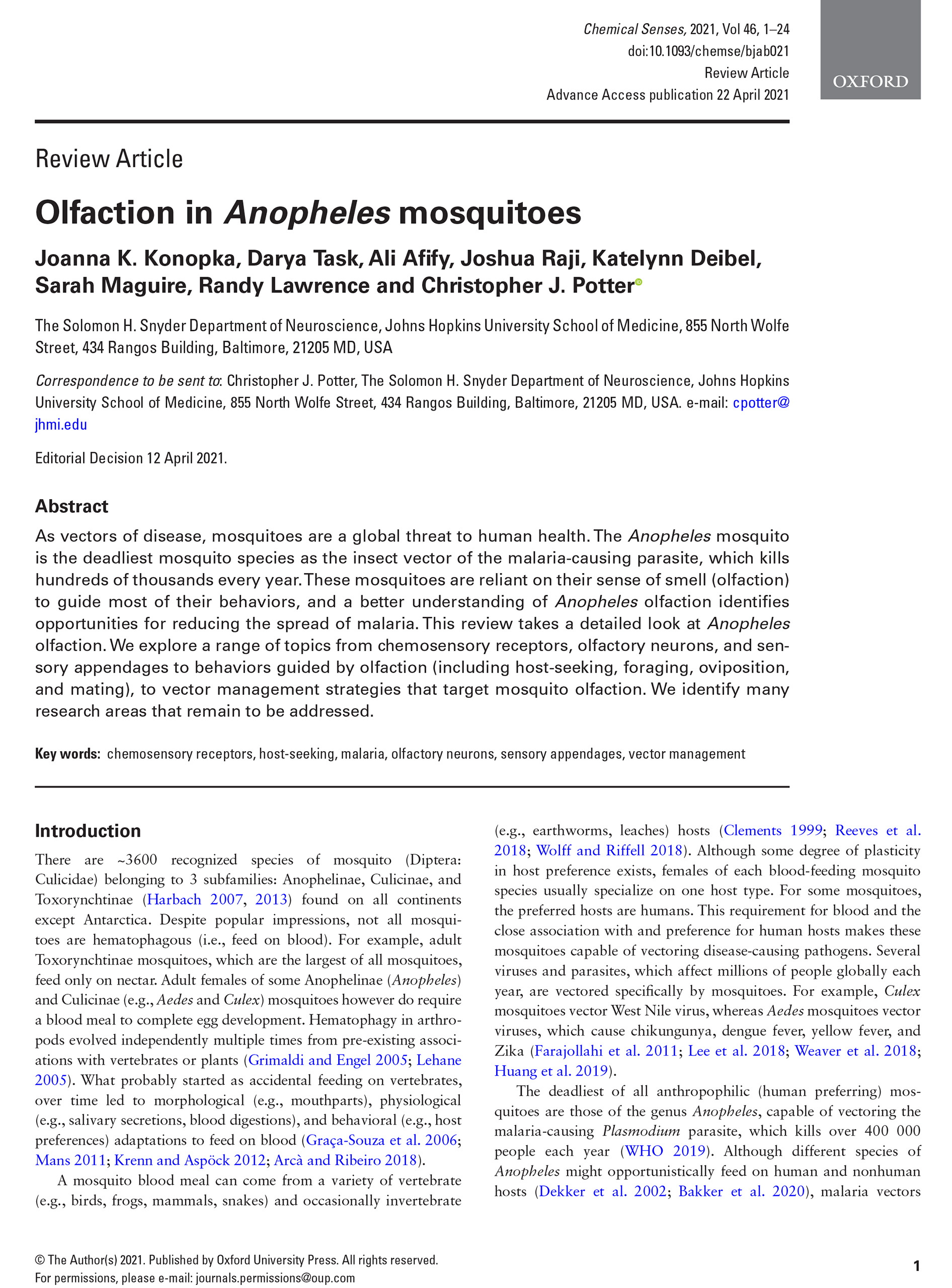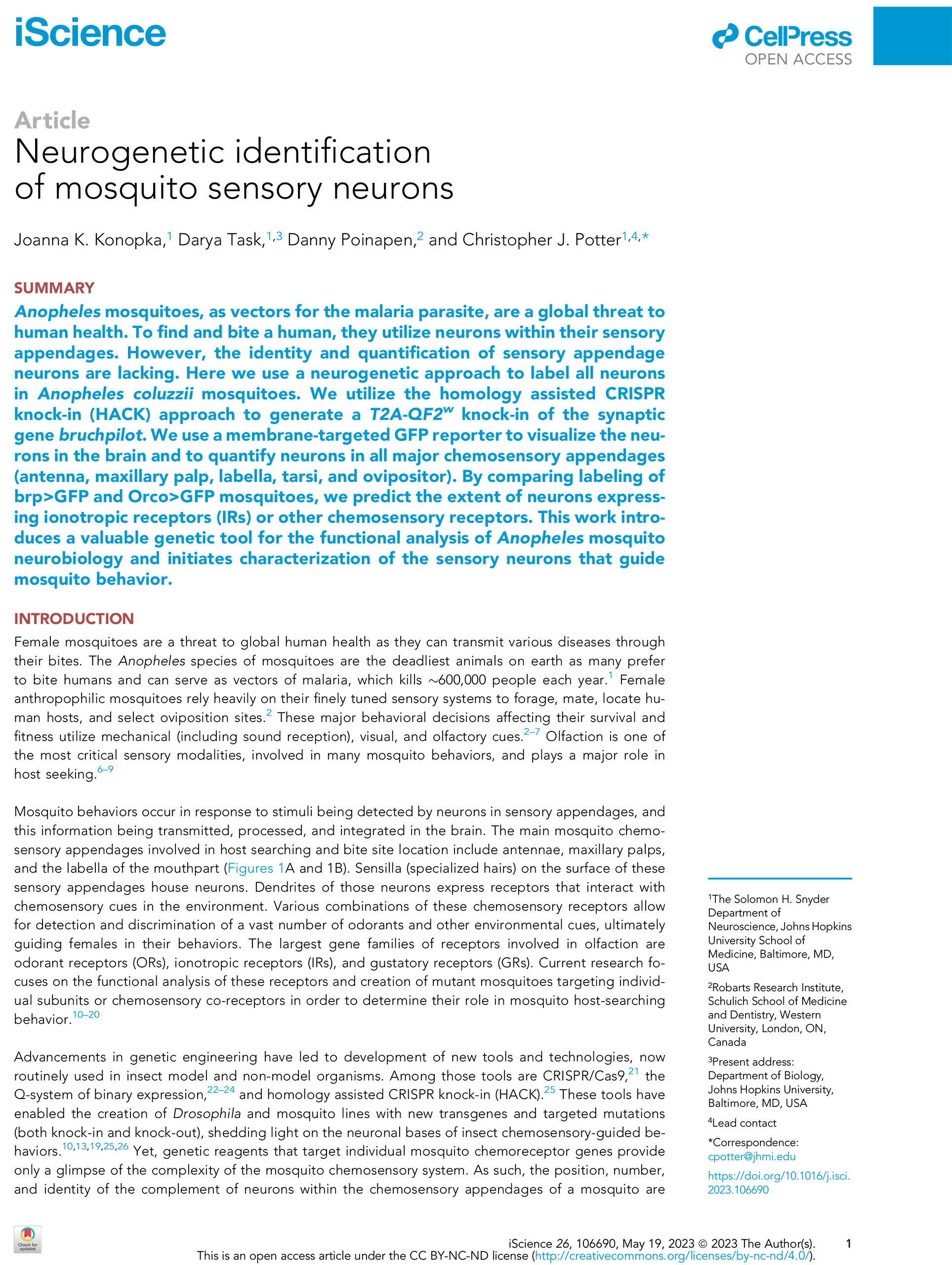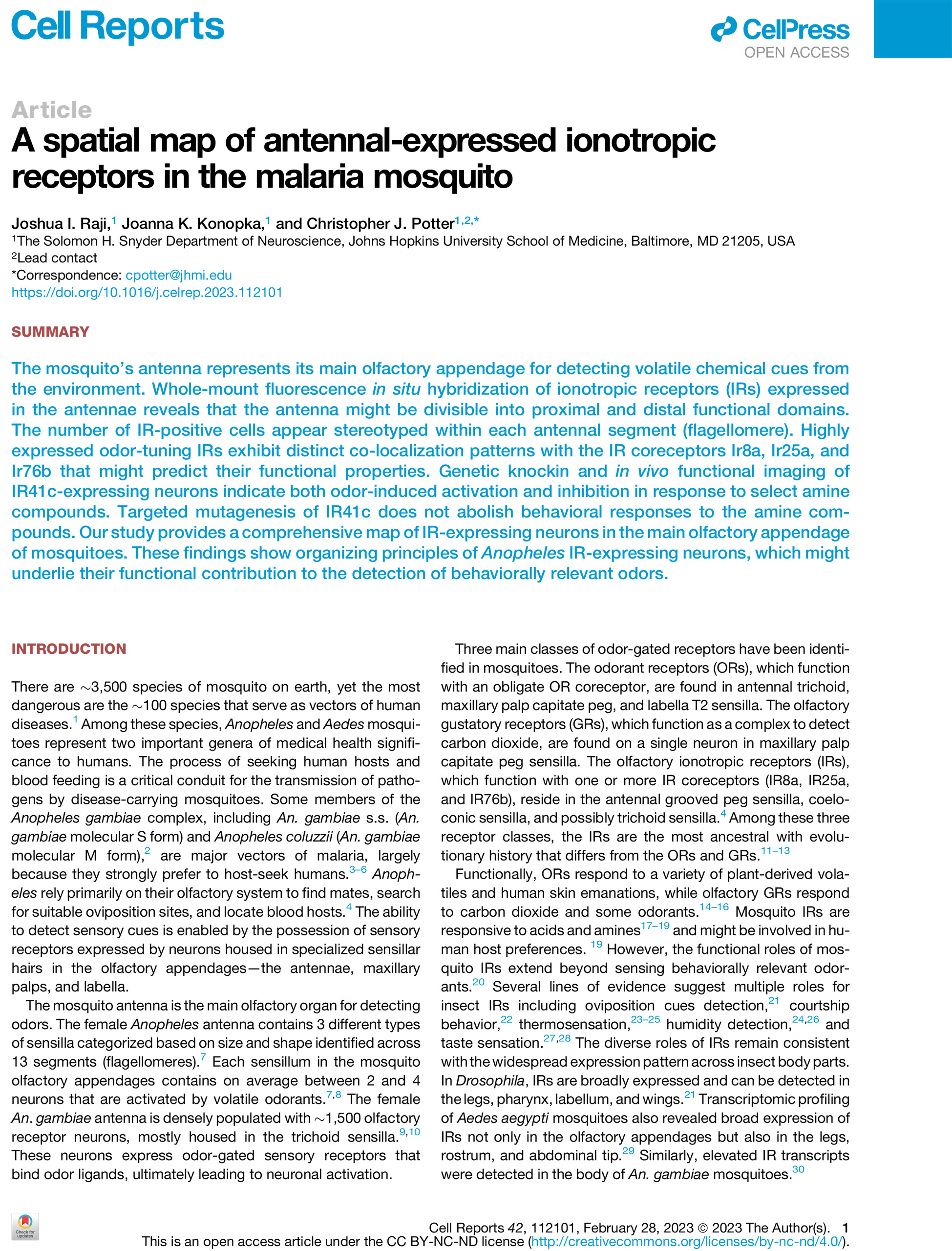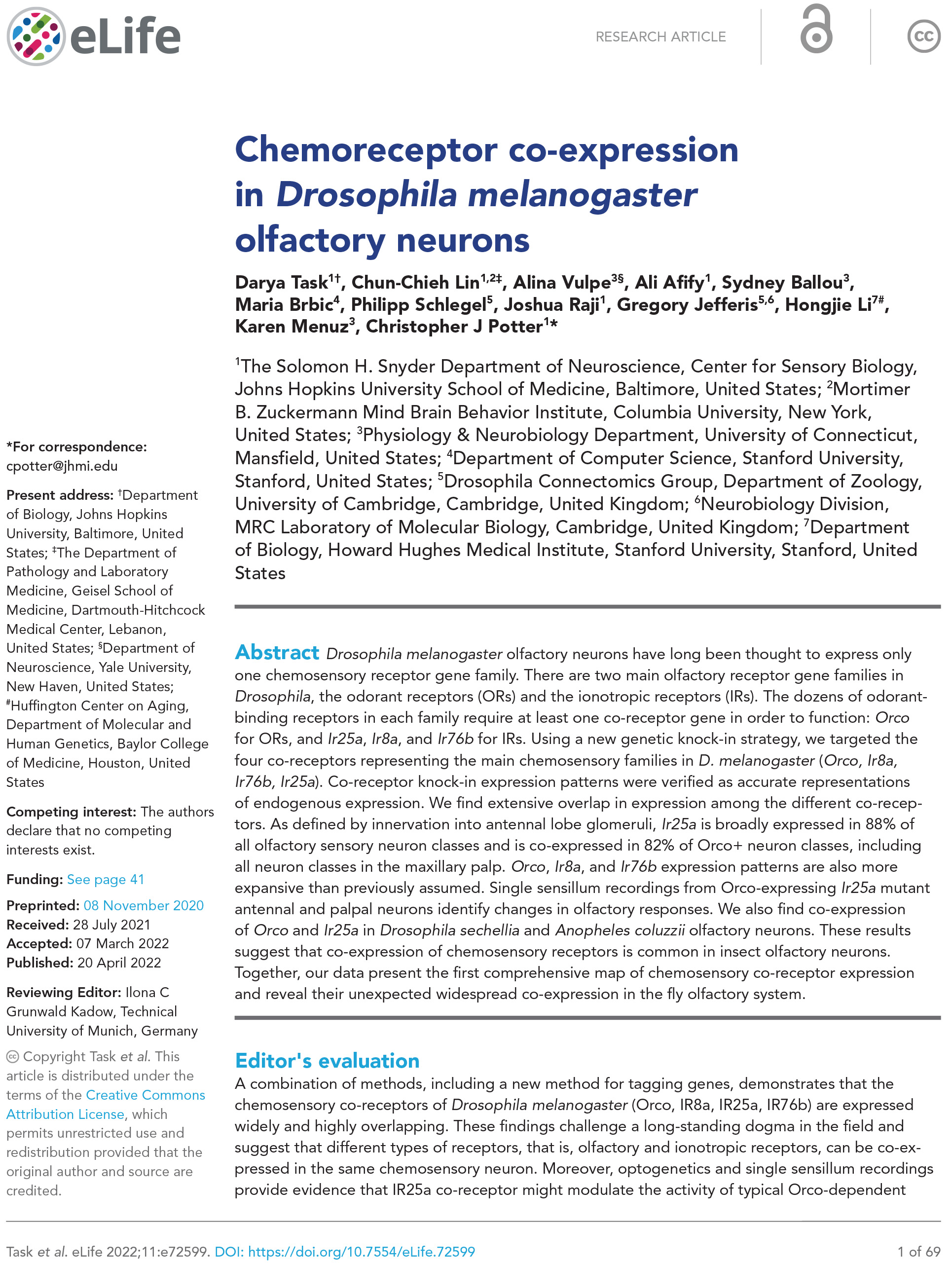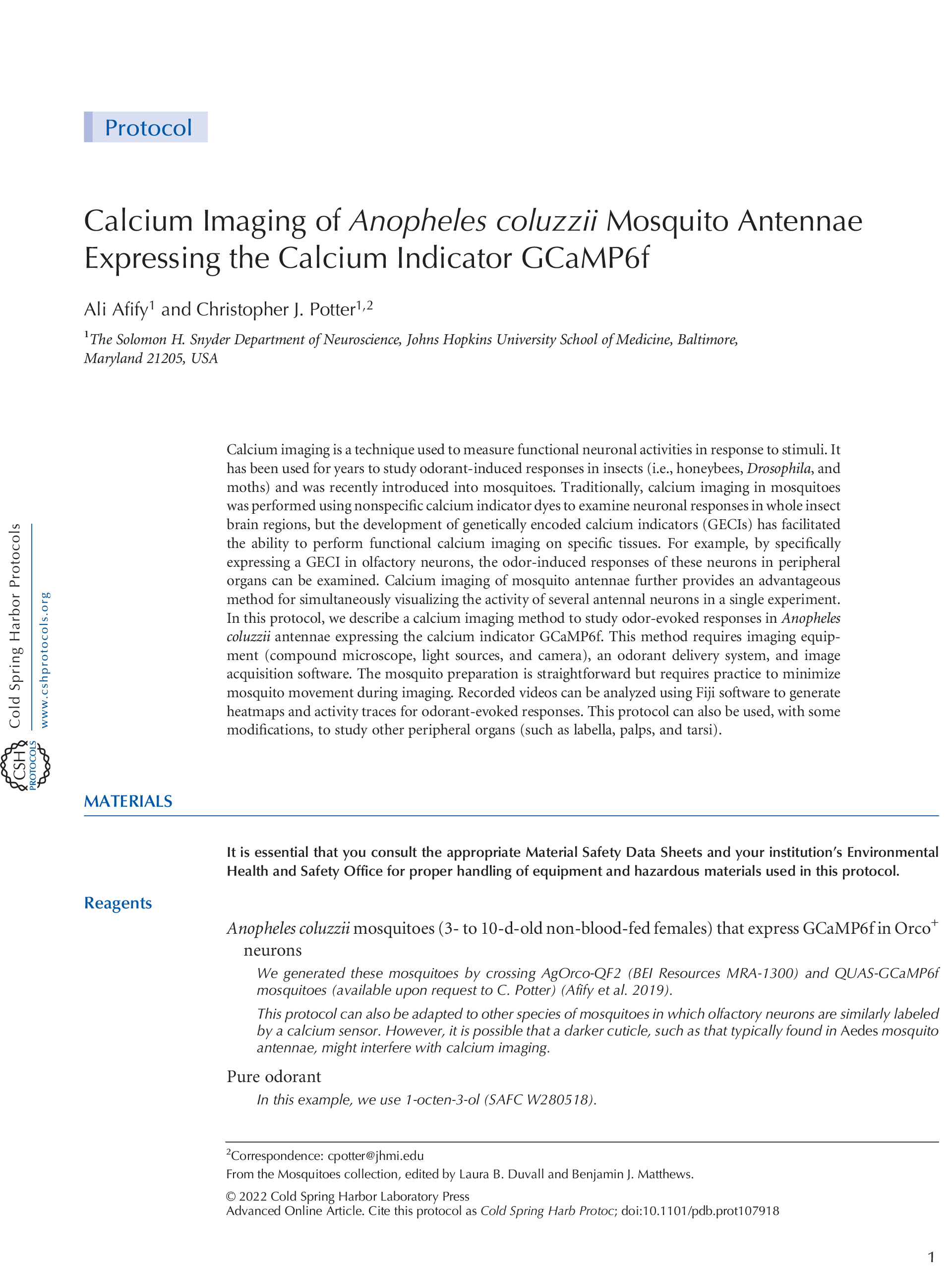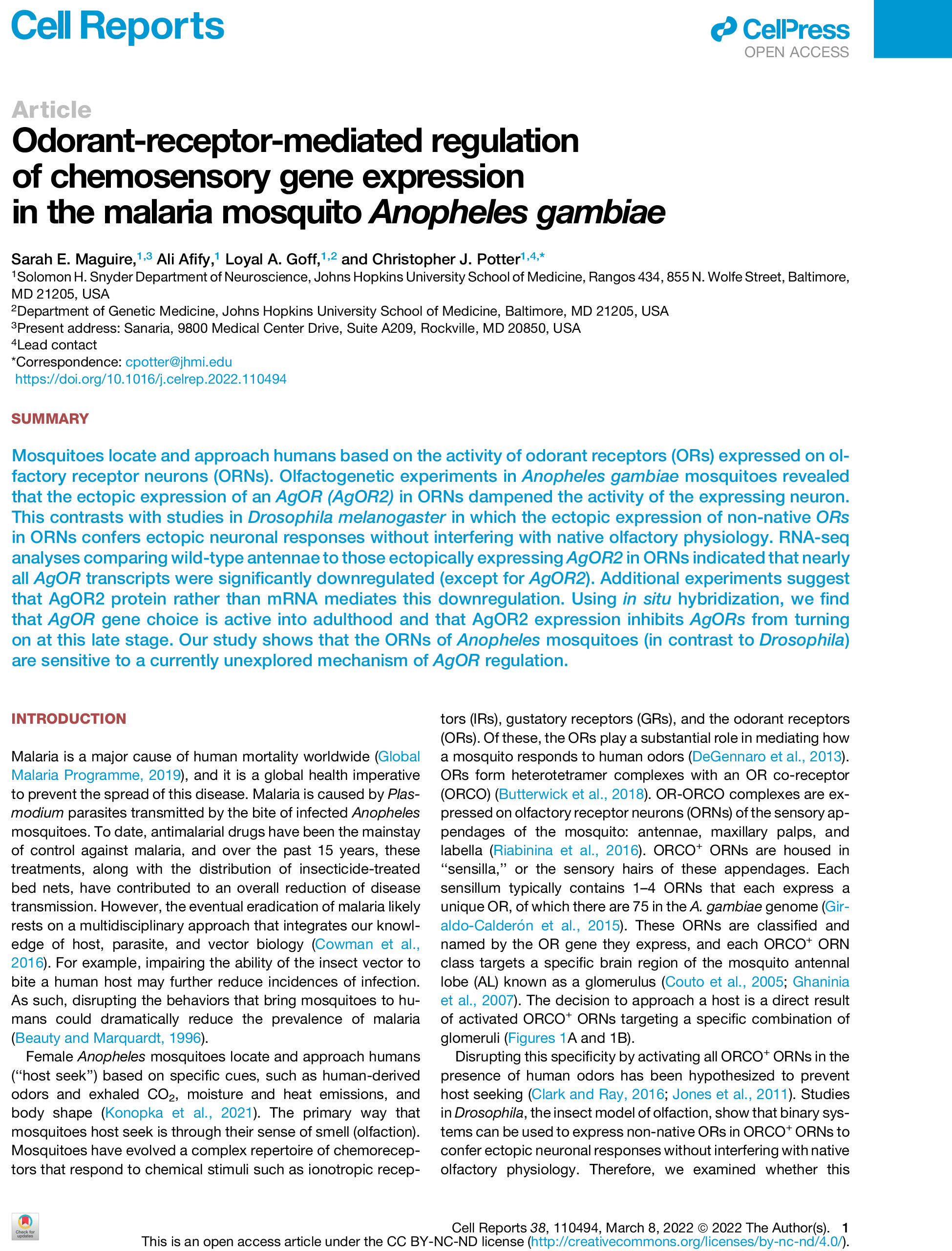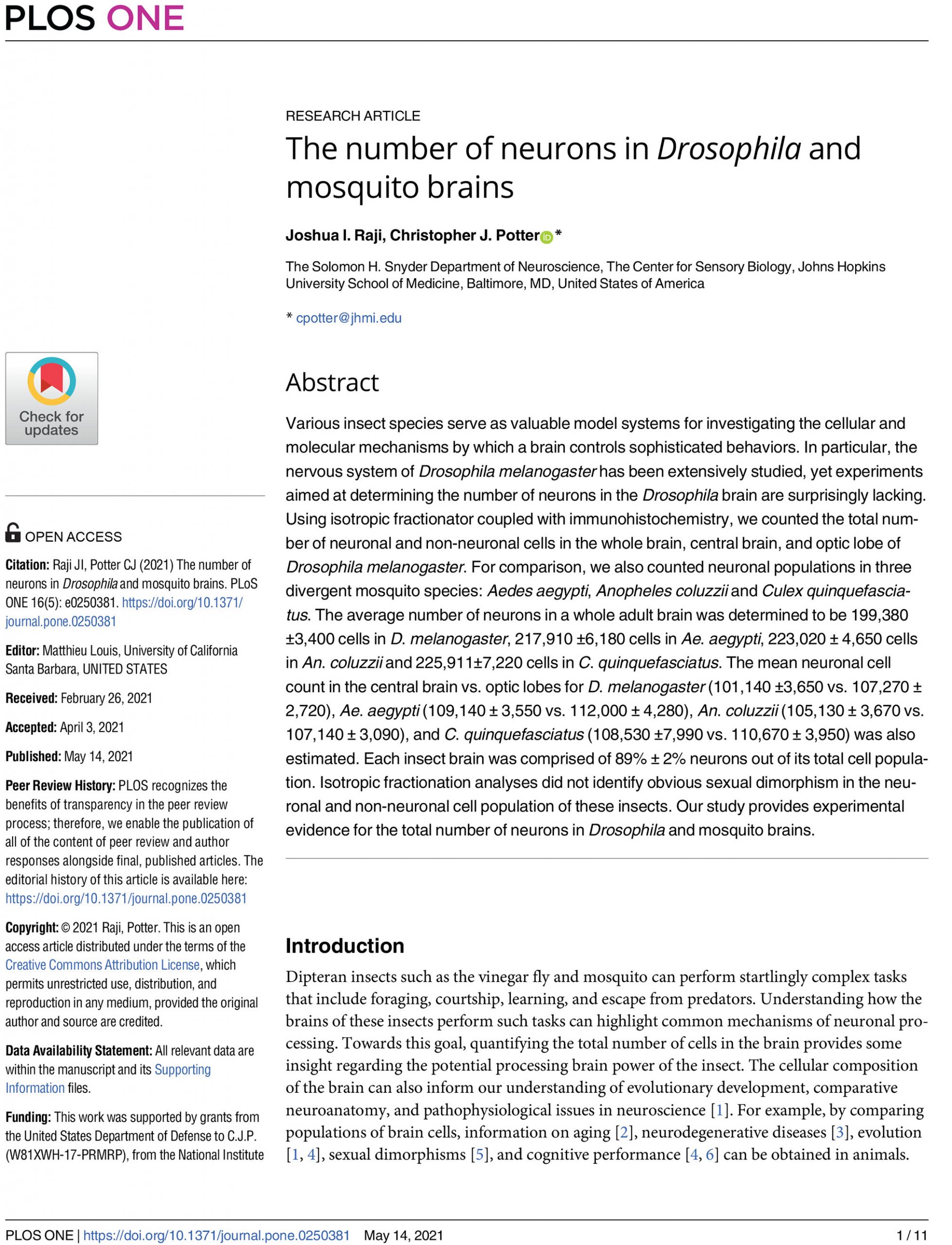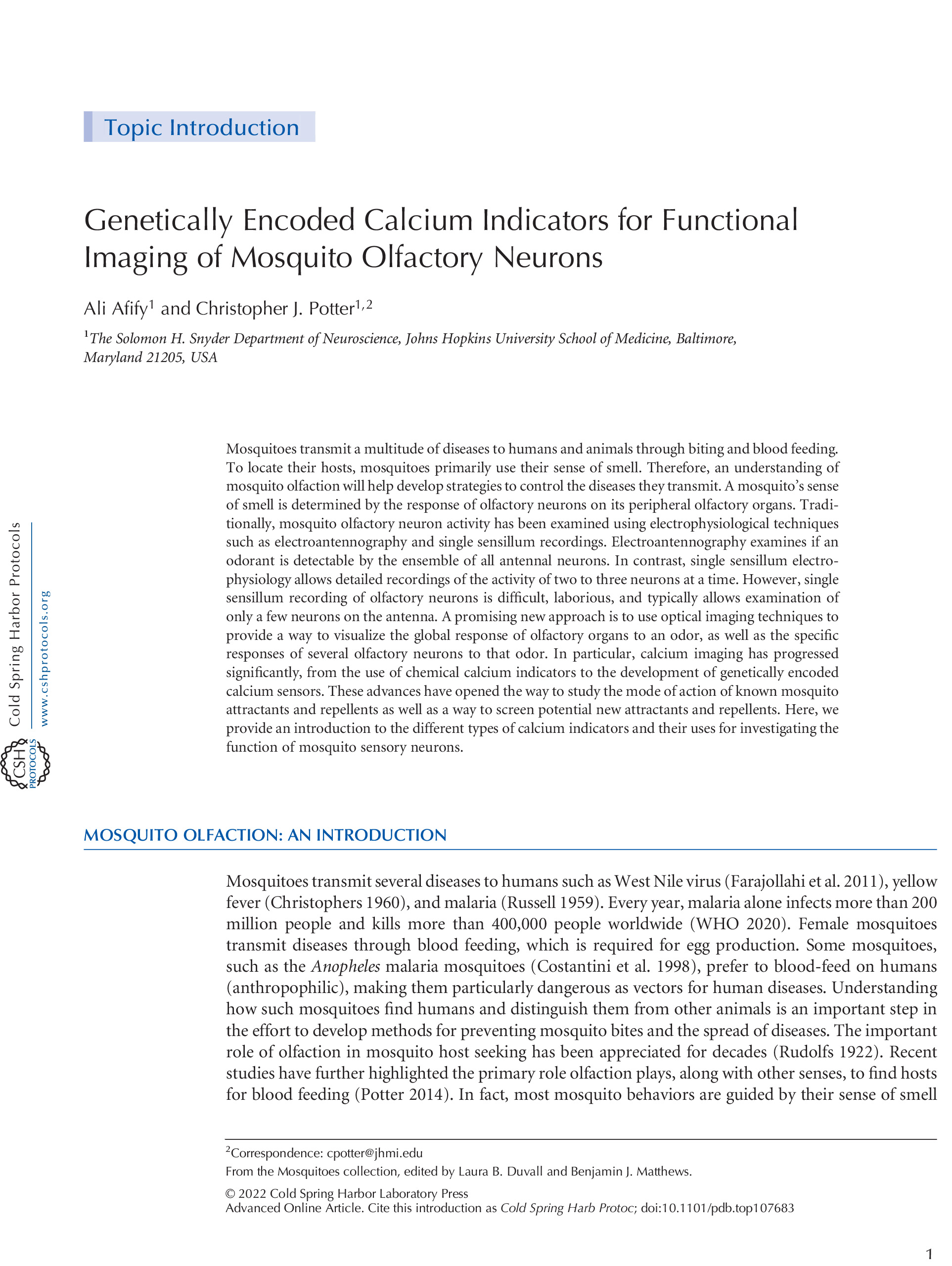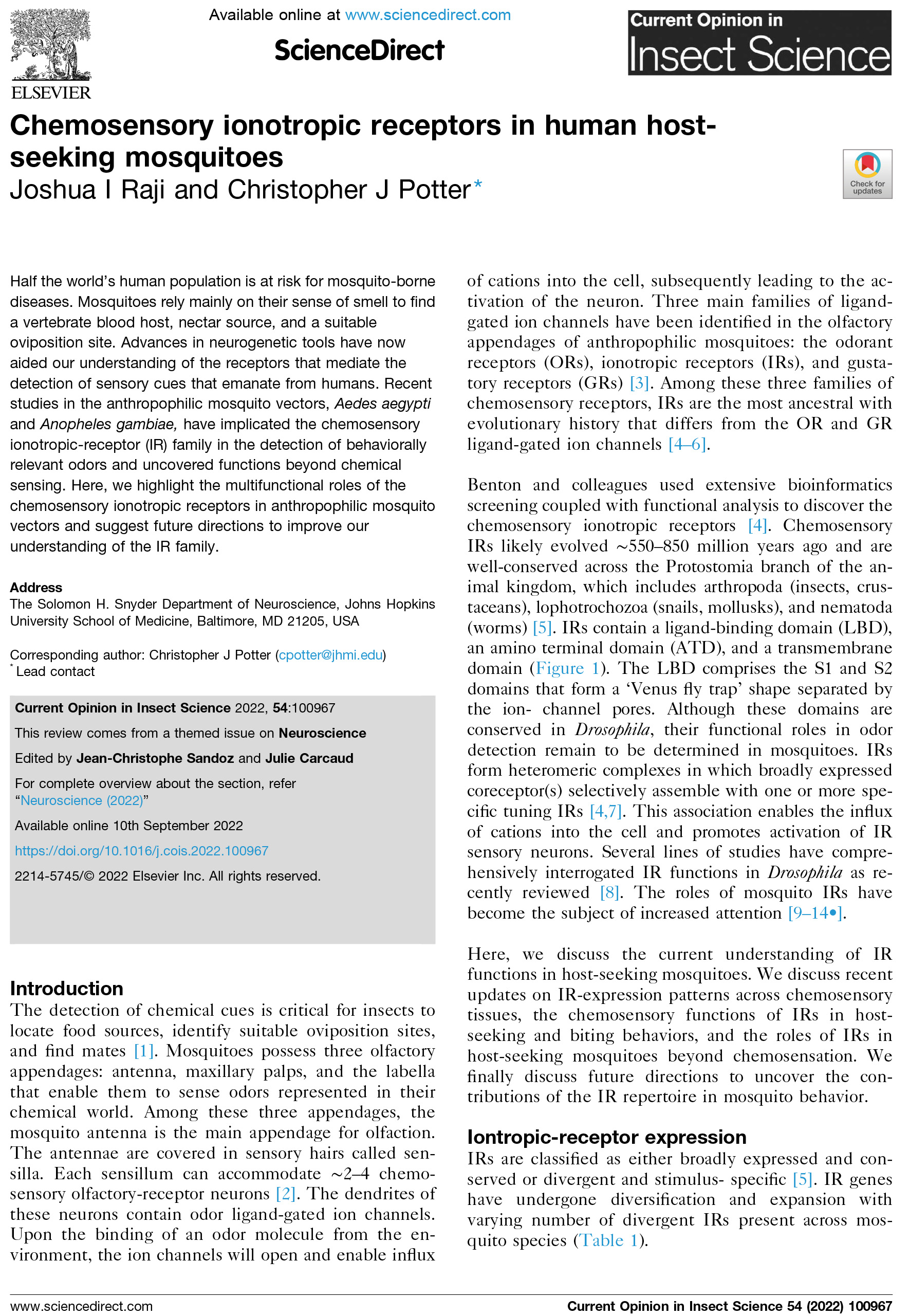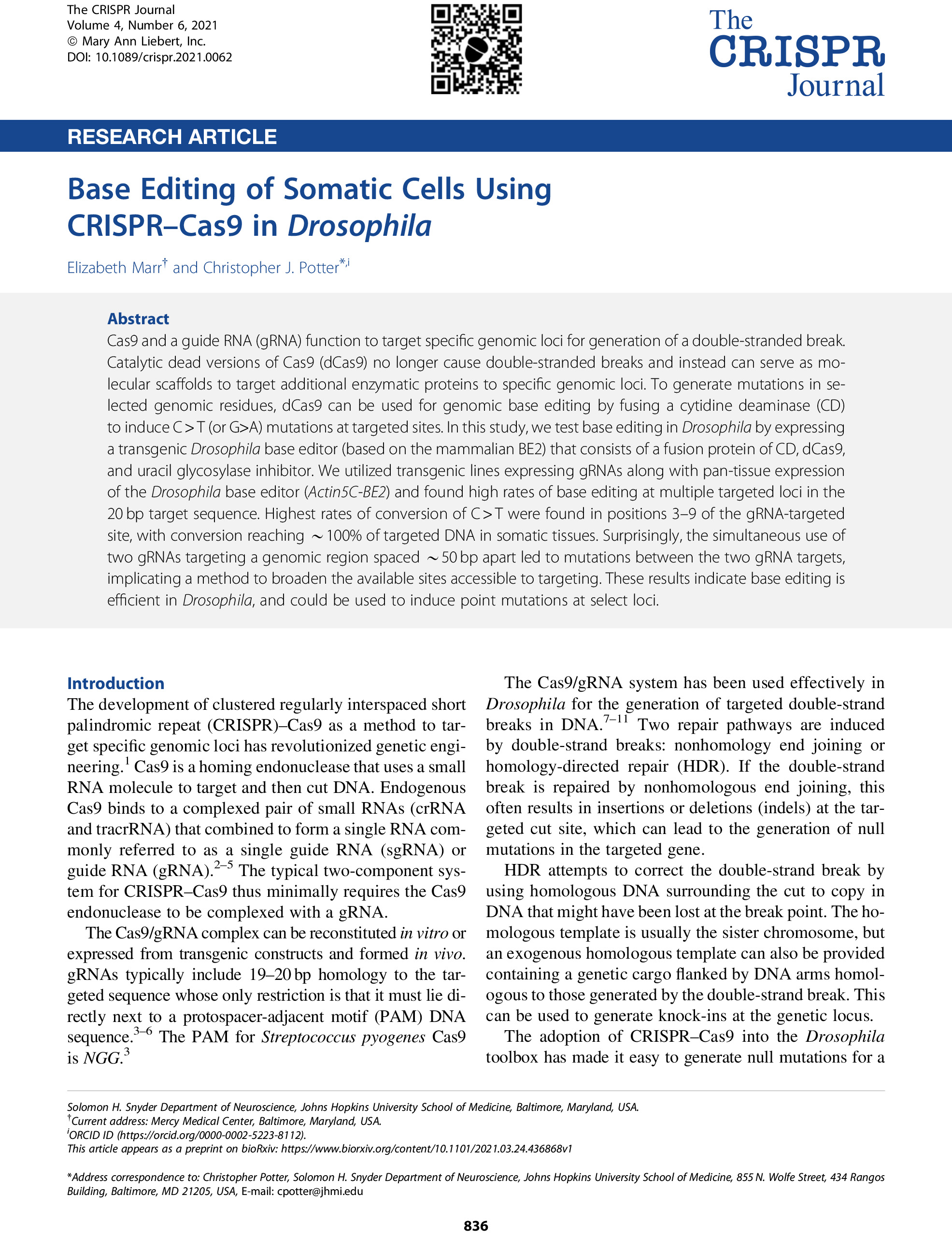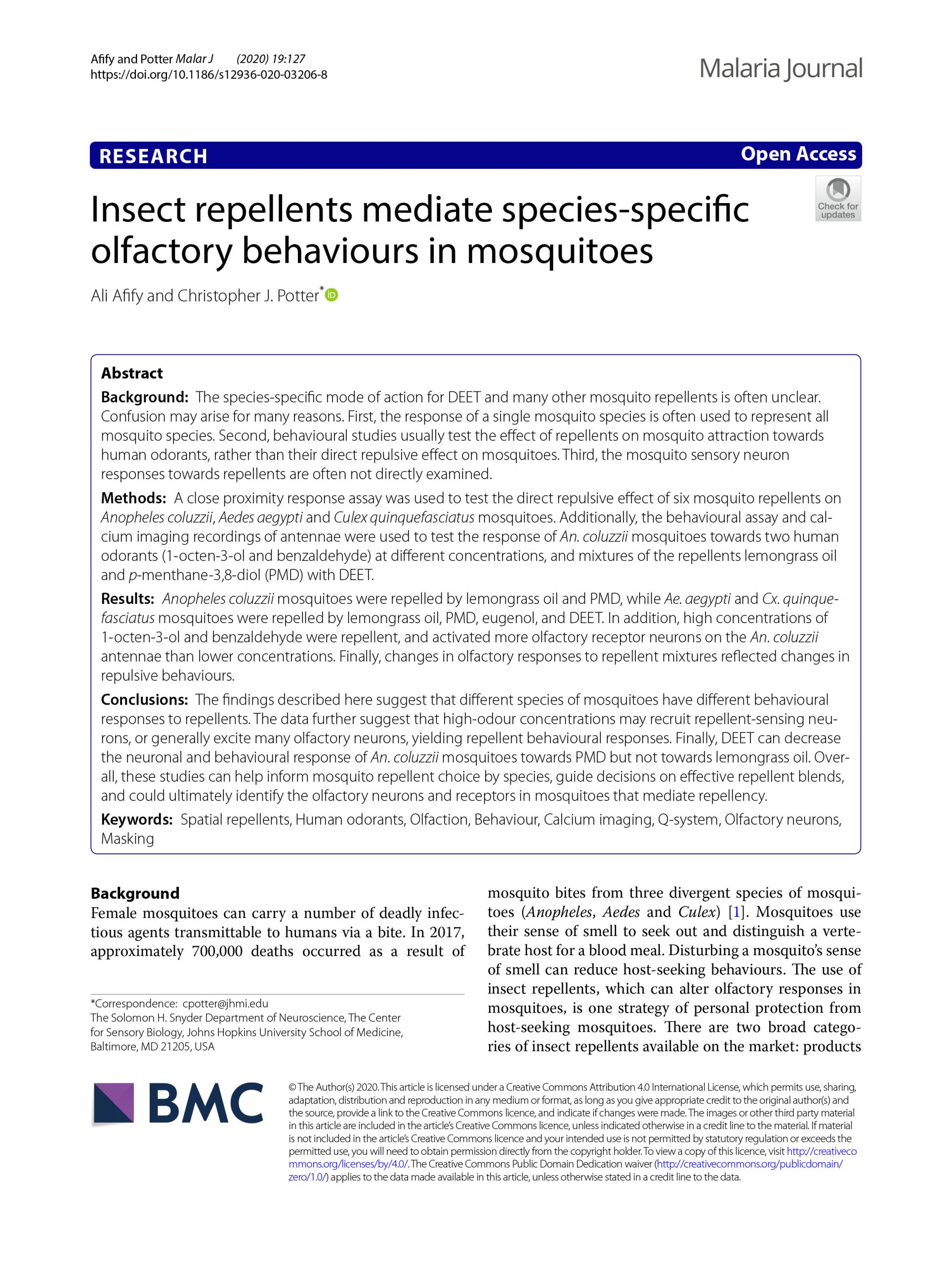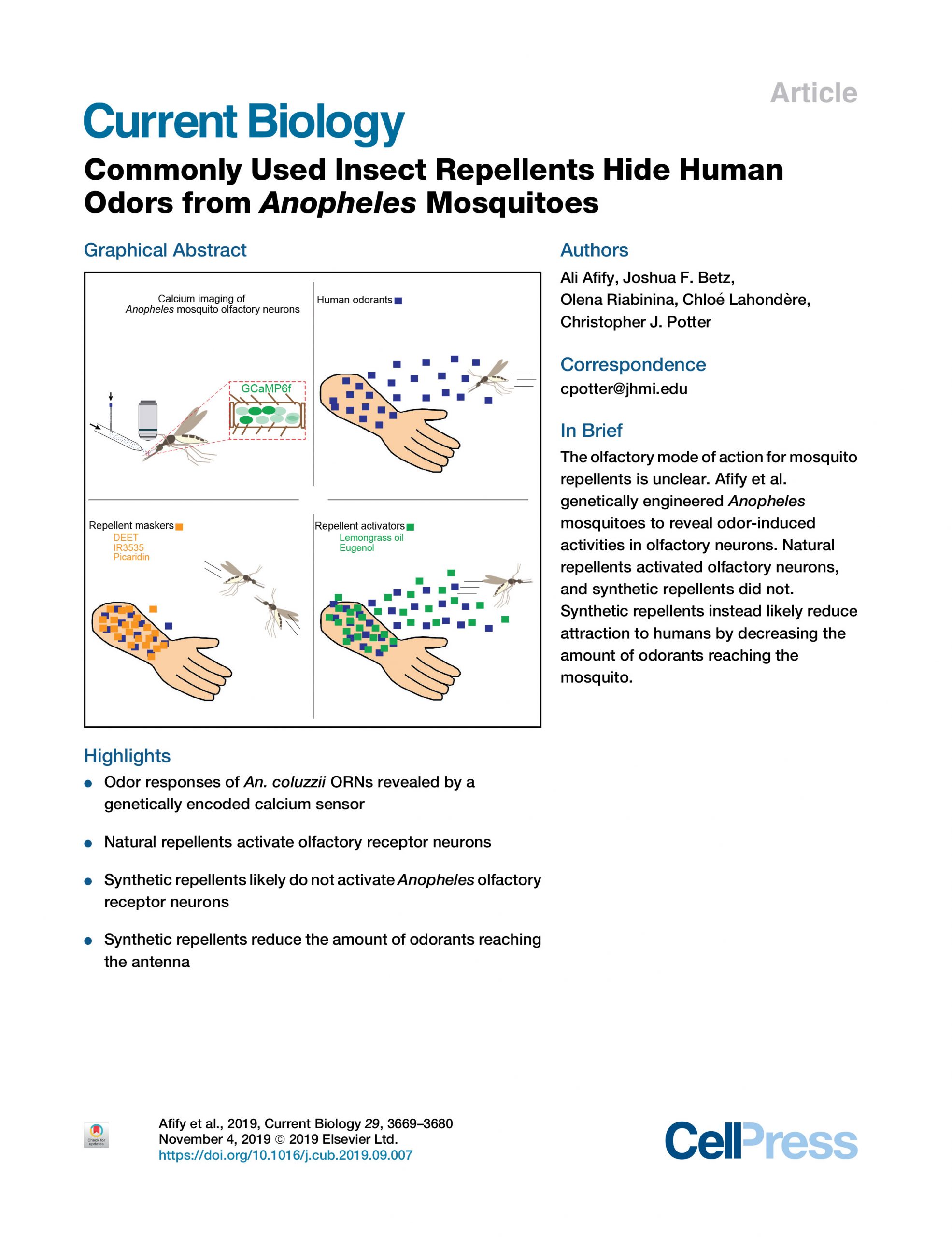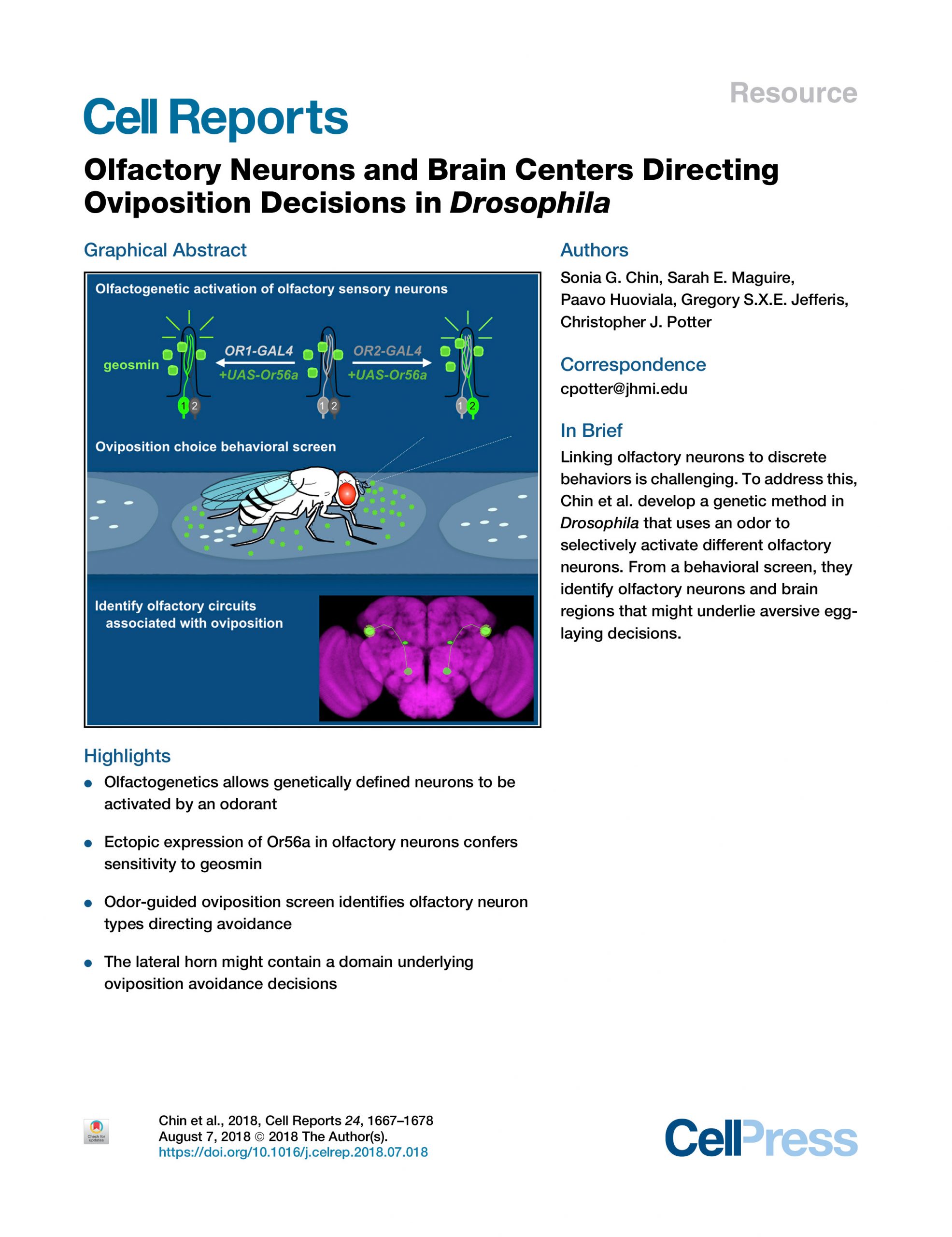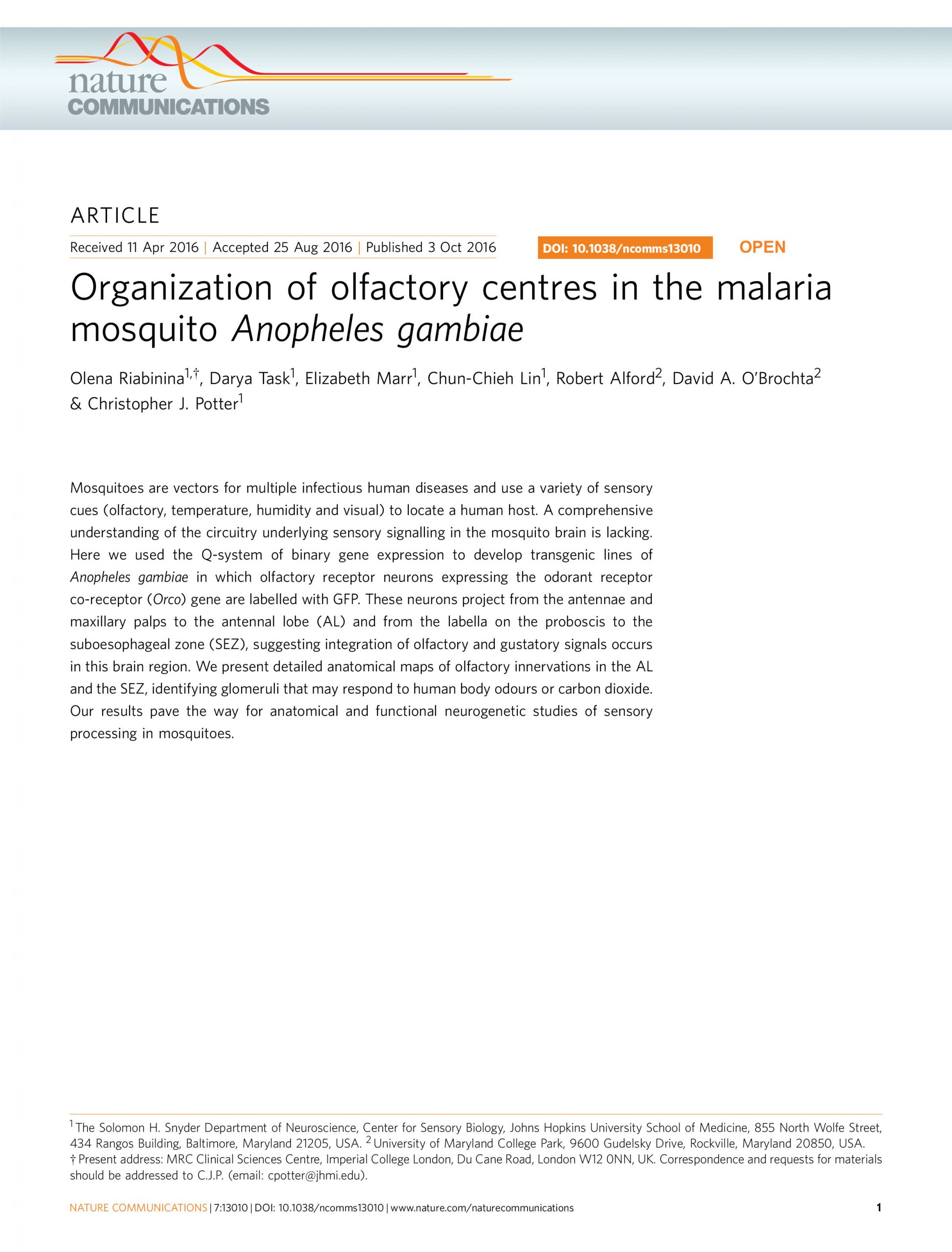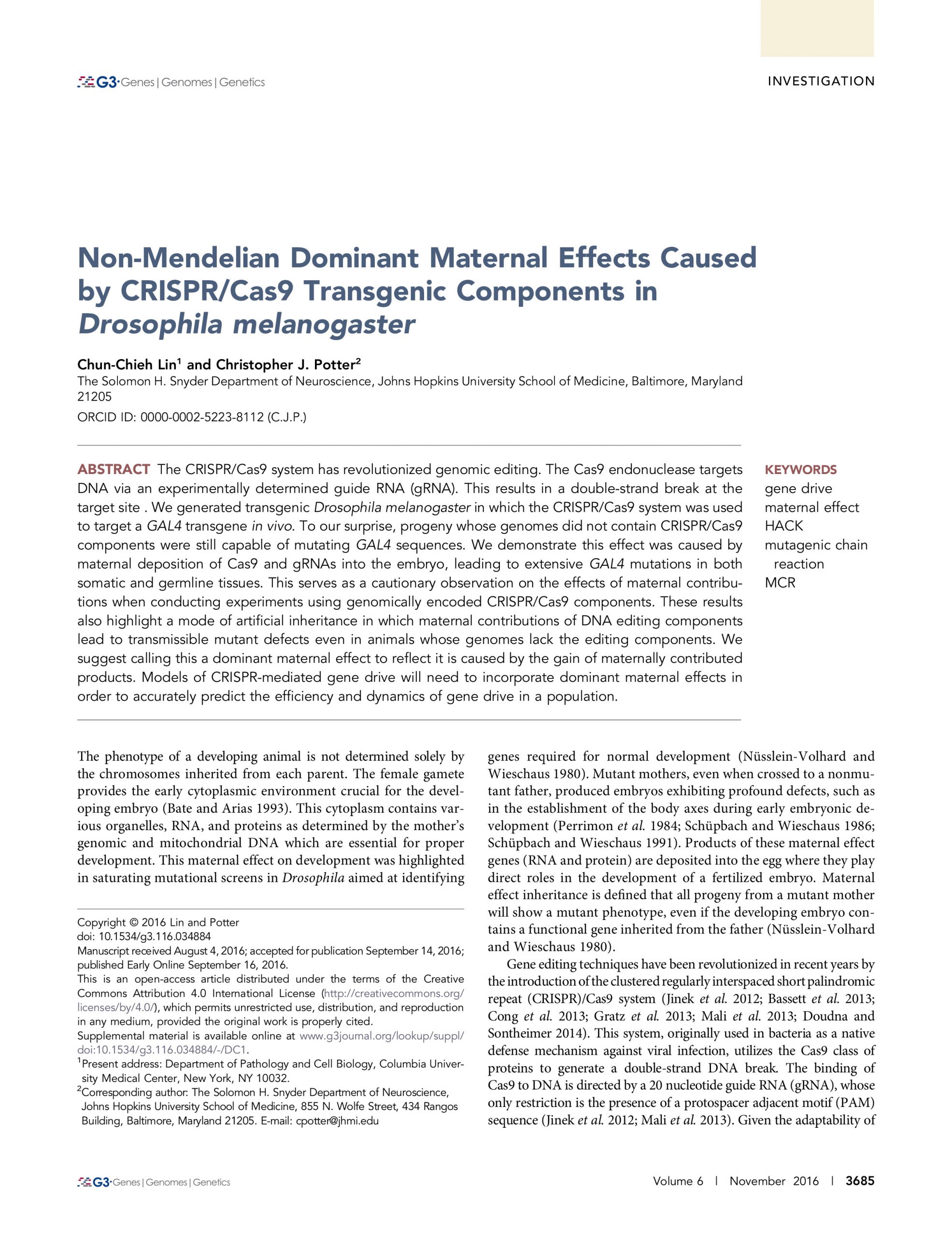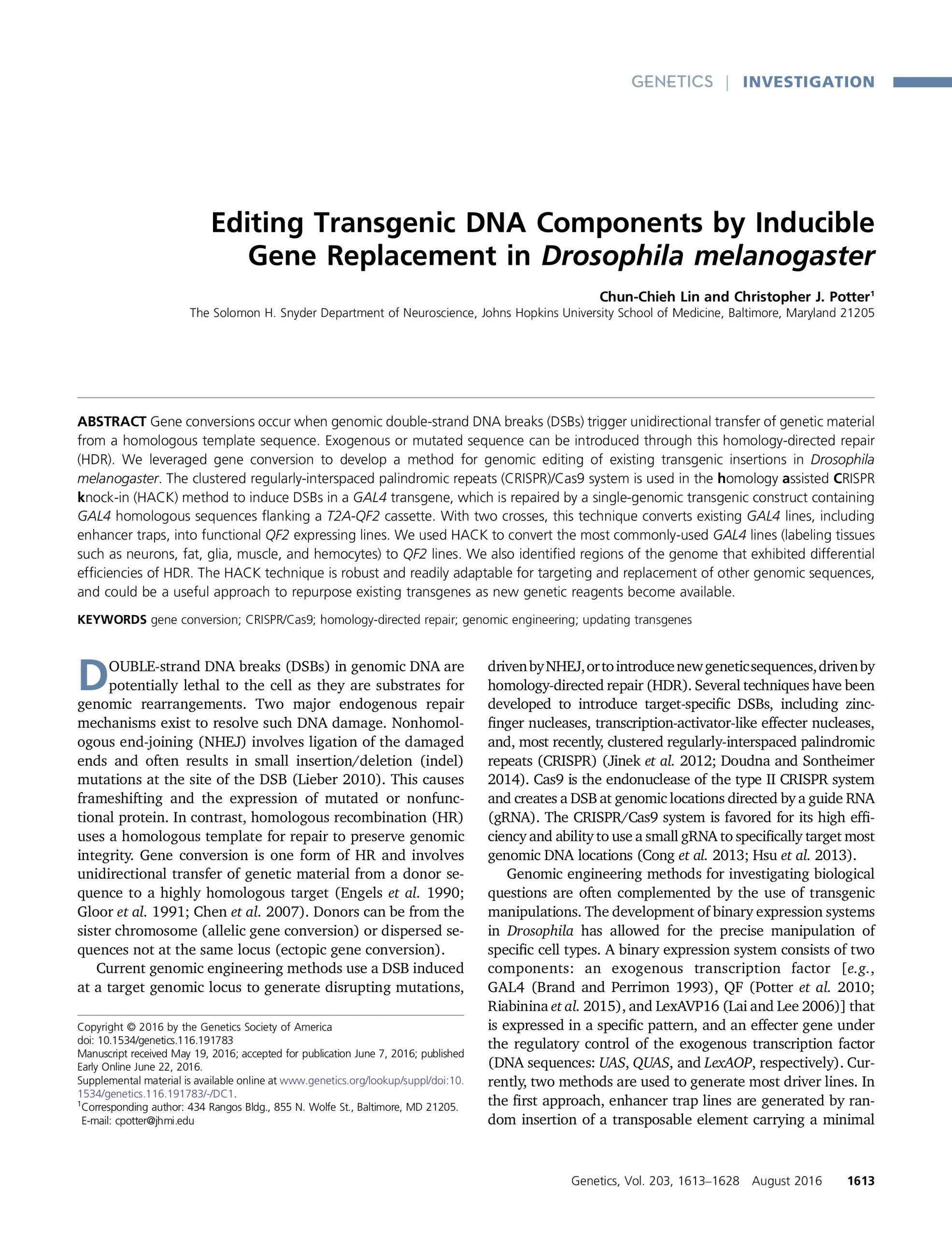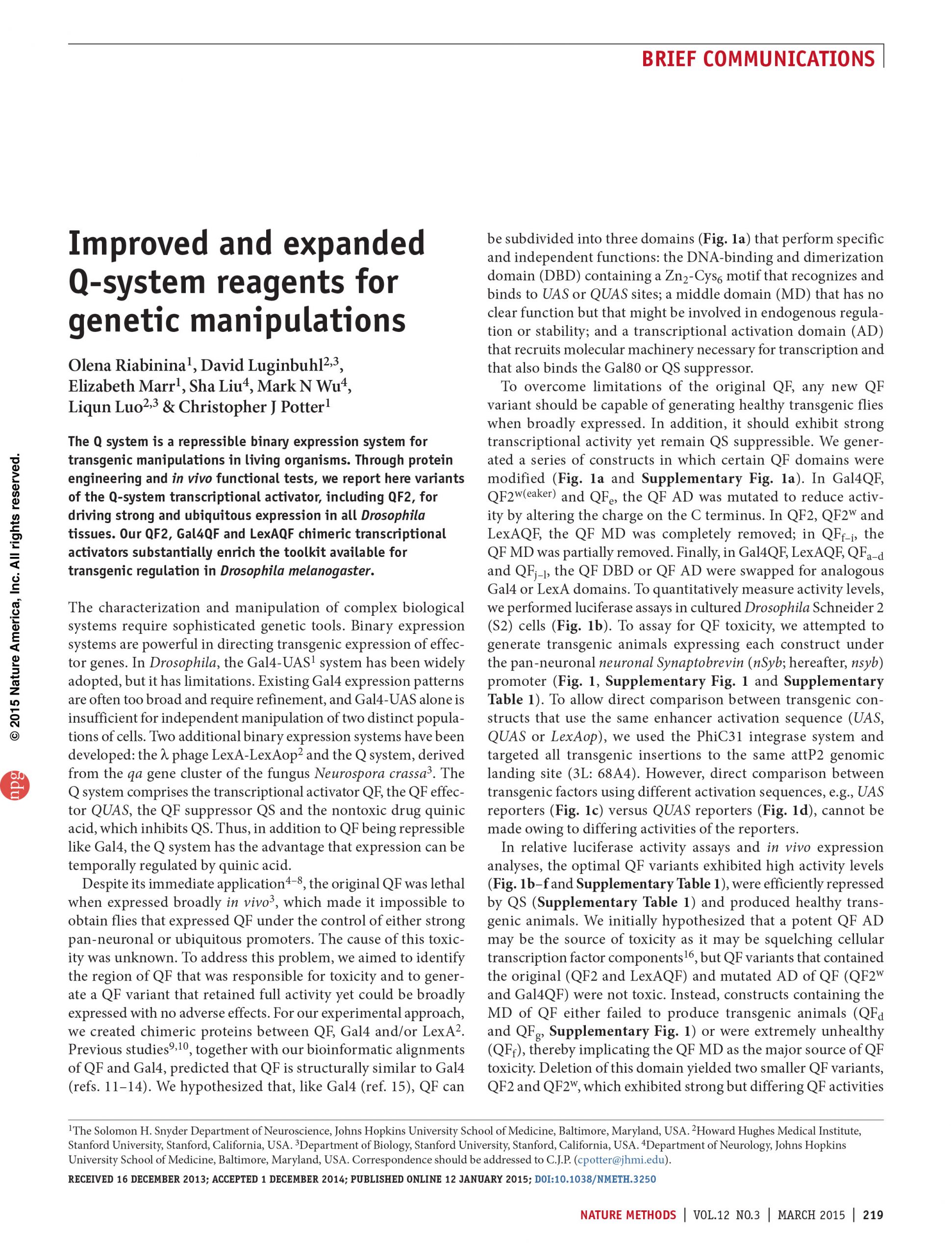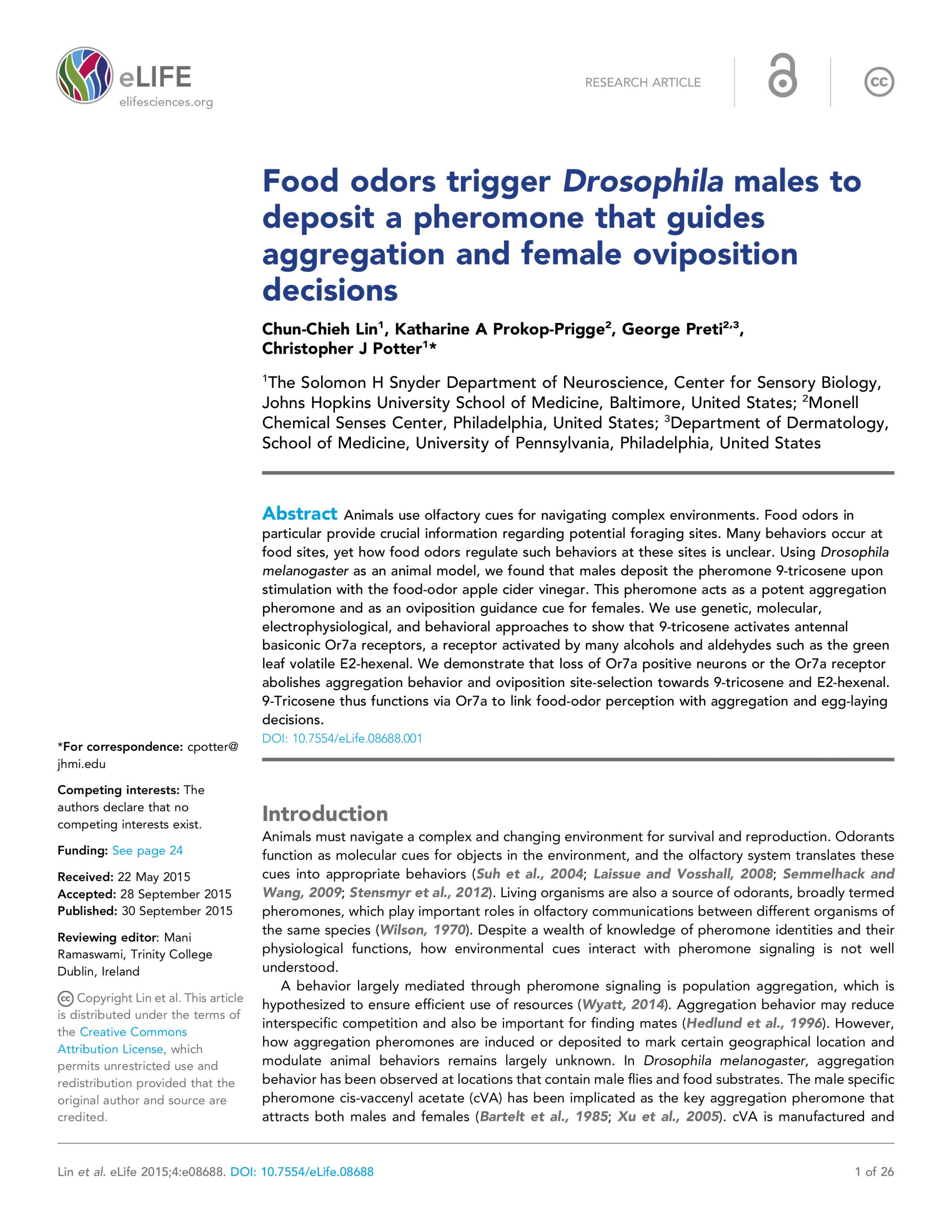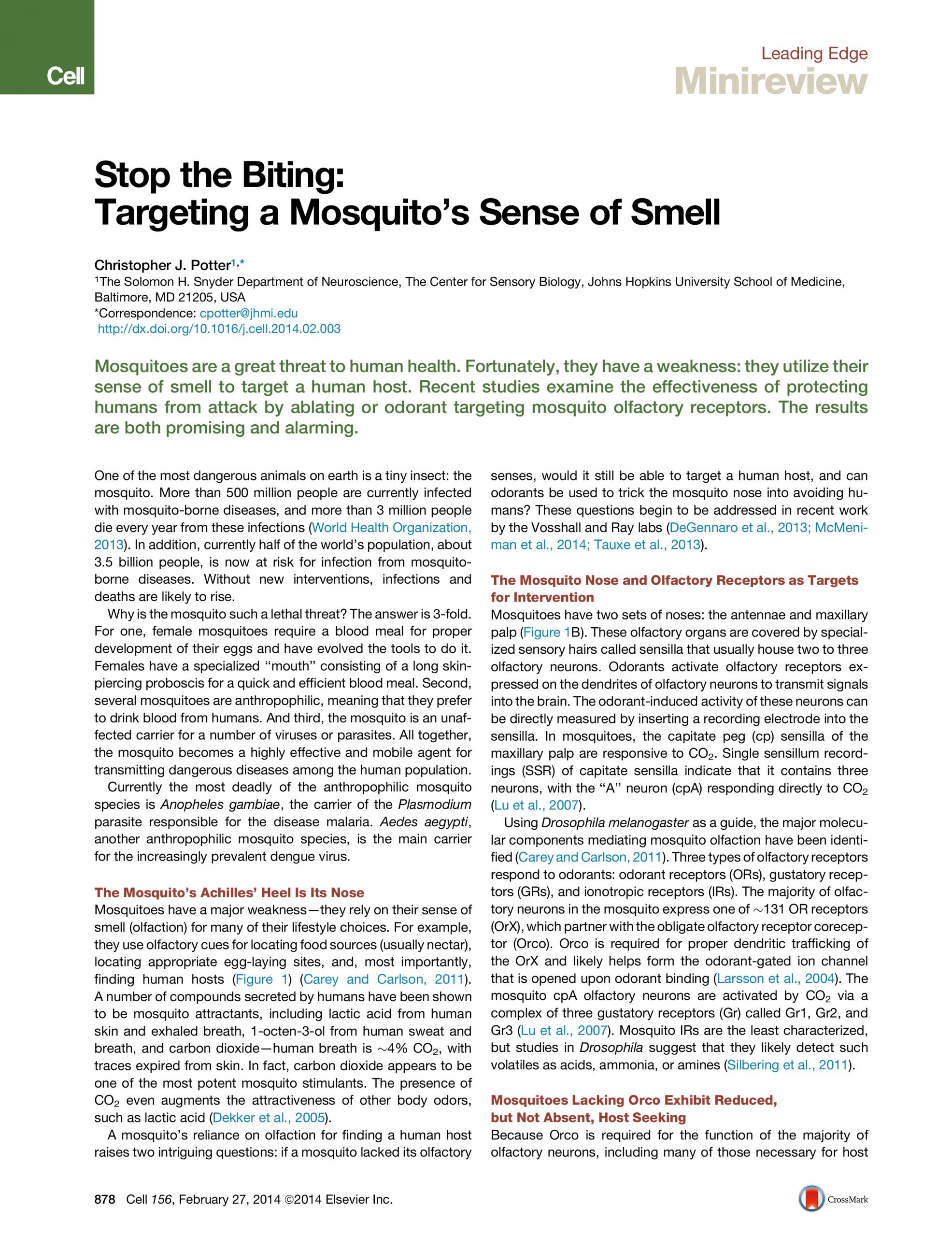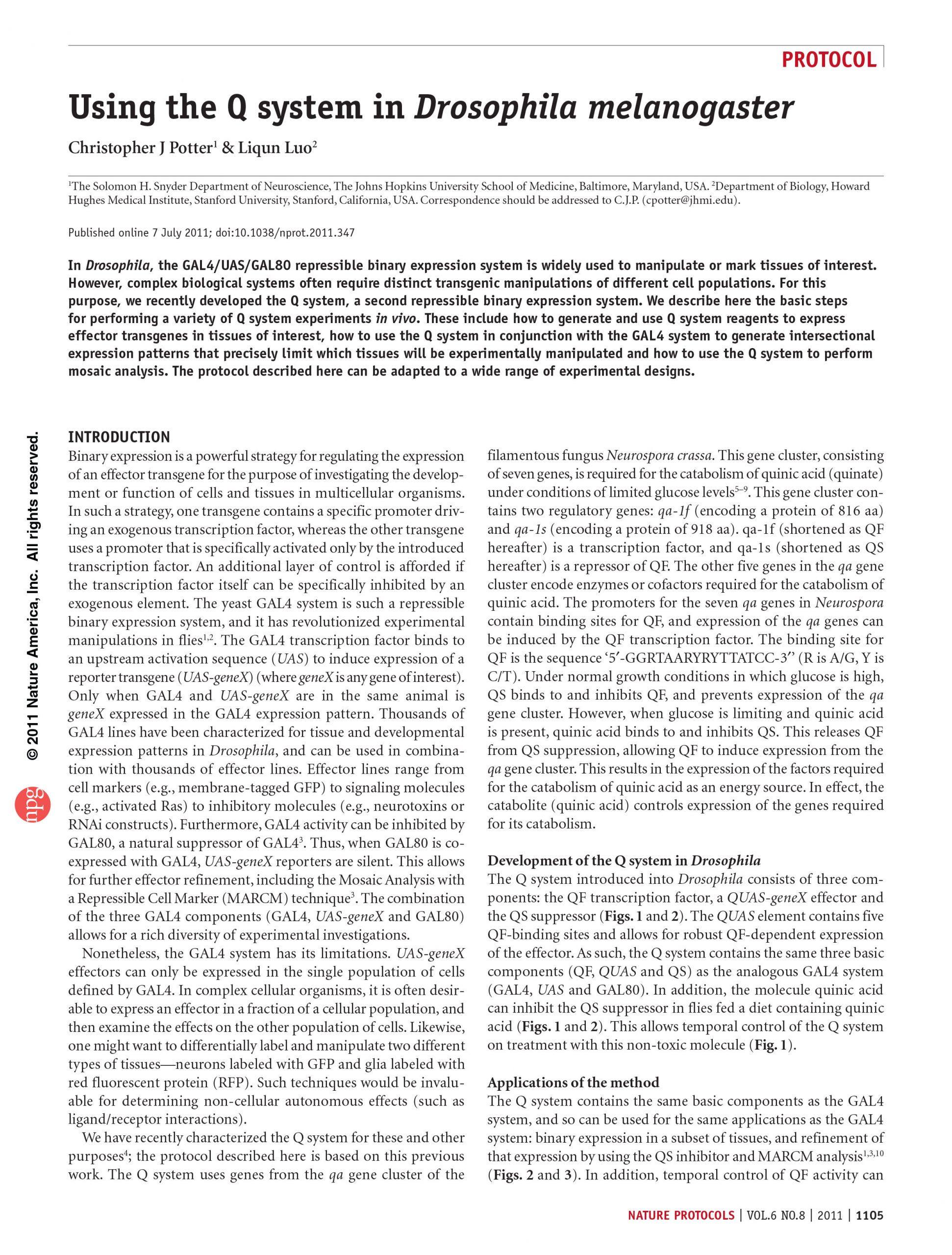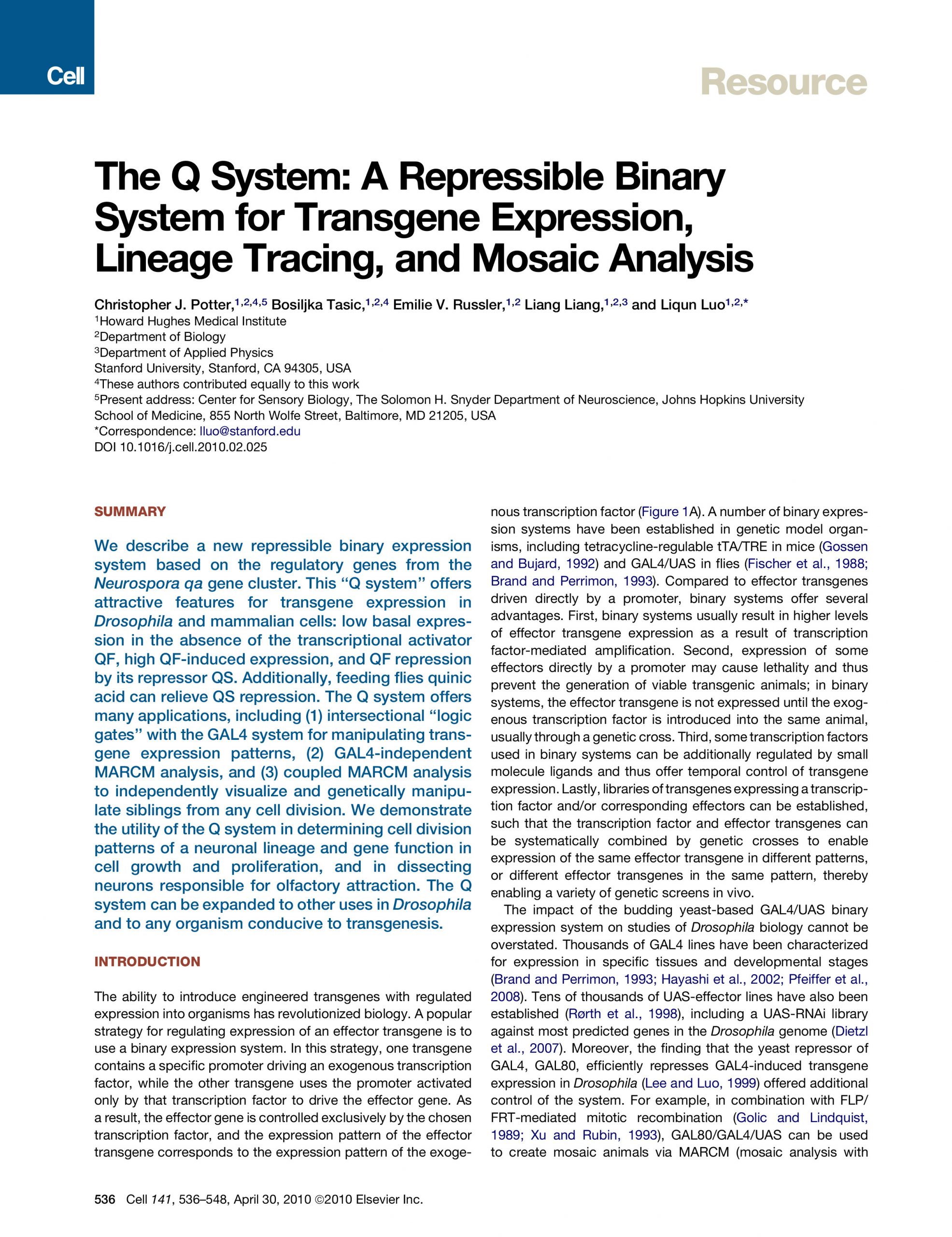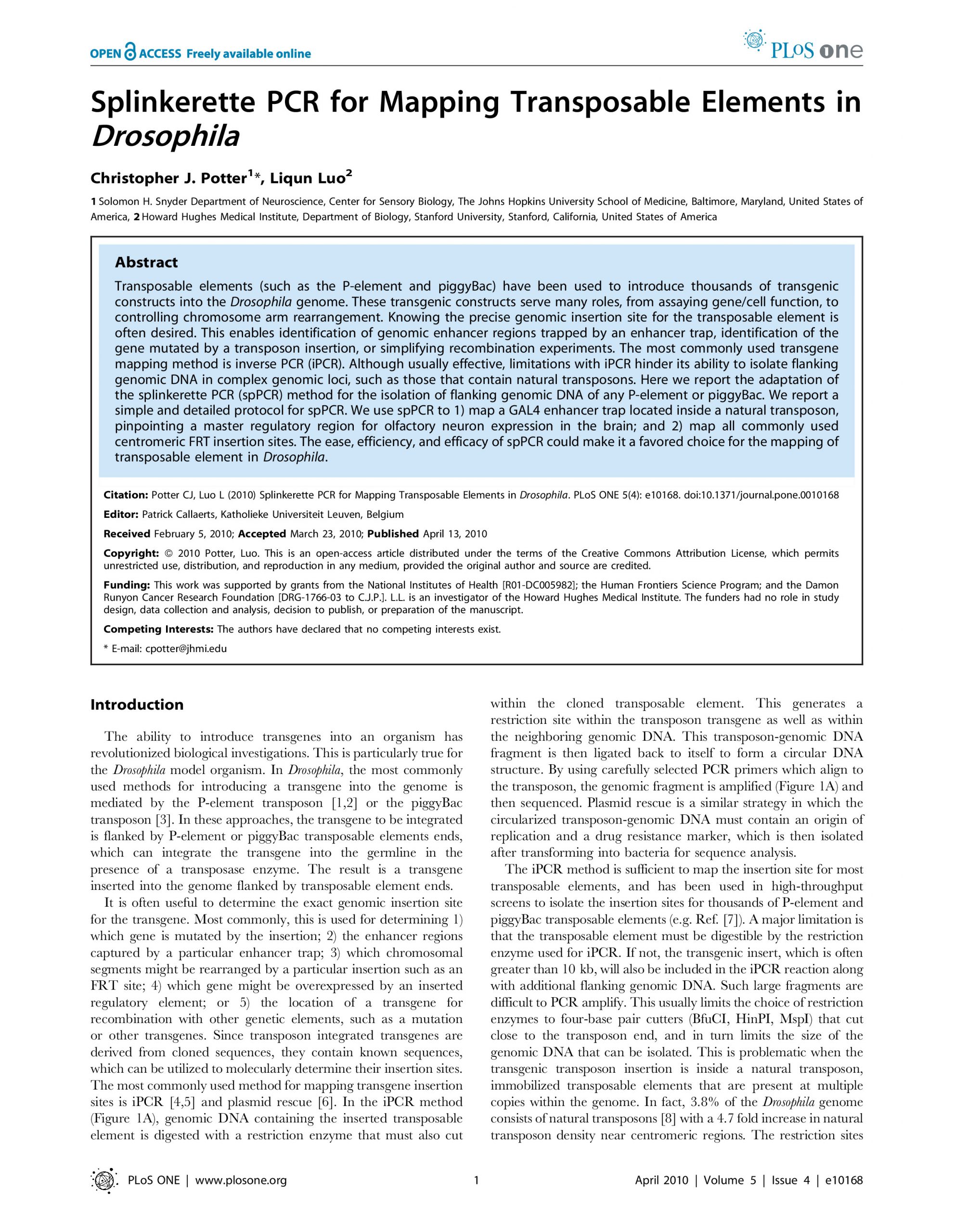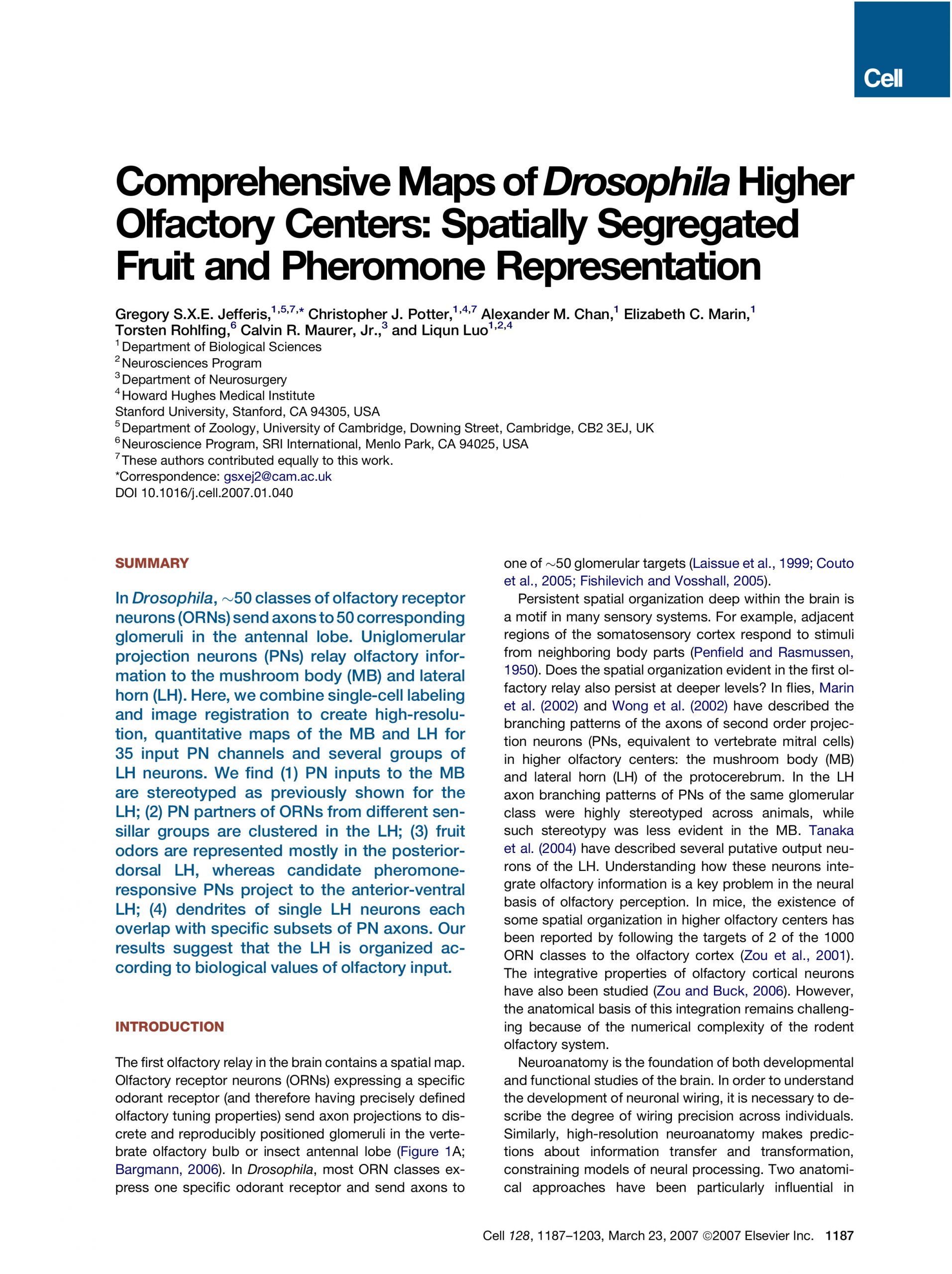Publications
View myBibliography from NCBI
2025
Meier CJ, Nguyen MN, Potter CJ. (2025). Making scents of mosquito repellent. Trends in Parasitology. Online March 10. https://doi.org/10.1016/j.pt.2025.02.009 Link
2024
Fernandez TM, Andreazza F, Melo N, Ignell R, Afify A, Li Y, Zhang DD, Potter CJ, Dong K, Stensmyr MC. (2024). Grapefruit-derived nootkatone potentiates GABAergic signaling and acts as a dual-action mosquito repellent and insecticide. Current Biology. Nov 25:S0960-9822(24)01494-5. PMID: 39631399. Link
2022
Konopka JK, Task D, Poinapen D, Potter CJ (2022). Neurogenetic identification of mosquito sensory neurons. bioRxiv 2022.11.22.517370. Link
Matinyan, N, Potter, CJ. “Chapter 29: Perspectives on the genetic manipulation of mosquitoes: advancements in studying sensory biology in vector insects” Sensory Ecology of Disease Vectors. Eds. R. Ignell, C.R. Lazzari, M.G. Lorenzo, S.R. Hill. Wageningen Academic Publishers, 2022. 743-771. Link
Raji JI, Potter CJ (2022). Chemosensory Ionotropic Receptors in Human Host-Seeking Mosquitoes. Current Opinion in Insect Science. 54:100967. doi:10.1016/j.cois.2022.100967. Link
Afify A, Potter CJ (2022). Calcium Imaging of Anopheles coluzzii Mosquito Antennae Expressing the Calcium Indicator GCaMP6f. Cold Spring Harbor Protocols doi:10.1101/pdb.prot107918. Link
Afify A, Potter CJ (2022). Genetically Encoded Calcium Indicators for Functional Imaging of Mosquito Olfactory Neurons. Cold Spring Harbor Protocols doi:10.1101/pdb.top107683. Link
Task D, Lin C-C, Vulpe A, Afify A, Ballou S, Brbic M, Schlegel P, Raji J, Jefferis GSXE, Li H, Menuz K, Potter CJ (2022). Chemoreceptor Co-Expression in Drosophila melanogaster Olfactory Neurons. eLife 2022;11:e72599. Link
Maguire SE, Afify A, Goff LA, Potter CJ (2022). Odorant-receptor-mediated regulation of chemosensory gene expression in the malaria mosquito Anopheles gambiae. Cell Reports, 38:110494. Link
2021
Marr E, Potter CJ (2021). Base Editing of Somatic Cells Using CRISPR-Cas9 in Drosophila. The CRISPR Journal, Nov 23 2021. doi: 10.1089/crispr.2021.0062. Link
Task D, Lin C-C, Vulpe A, Afify A, Ballou S, Brbic M, Schlegel P, Jefferis GSXE, Li H, Menuz K, Potter CJ (2021). Chemoreceptor Co-Expression in Drosophila Olfactory Neurons. bioRxiv, July 28. Link
Potter CJ (2021). Unlocking pan-neuronal expression in mosquitoes. (Preview) Cell Reports Methods, Volume 1, Issue 3, 100051. Link
Raji JI, Potter CJ (2021). The number of neurons in Drosophila and mosquito brains. PLOS ONE 16(5): e0250381. https://doi.org/10.1371/journal.pone.0250381. Link
Task, D, Potter, CJ (2021). Rapid degeneration of Drosophila olfactory neurons in Orco mutant maxillary palps. microPublication Biology. 10.17912/micropub.biology.000398. Link
Konopka JK, Task D, Afify A, Raji J, Deibel K, Maguire S, Lawrence R, Potter CJ (2021). Olfaction in Anopheles mosquitoes. Chemical Senses, bjab021. Link
Melo N, Capek M, Arenas OM, Afify A, Potter CJ, Laminette PJ, Para A, Gallio M, Stensmyr MC (2021). The irritant receptor TRPA1 mediates the mosquito repellent effect of catnip. Current Biology. 2021; 31:1-7. Link
Marr E, Potter CJ (2021). Base editing using CRISPR/Cas9 in Drosophila. bioRxiv 2021.03.24.436868. Link
2020
Task D, Lin C-C, Afify A, Li H, Vulpe A, Menuz M, Potter CJ (2020). Widespread Polymodal Chemosensory Receptor Expression in Drosophila Olfactory Neurons. bioRxiv, Nov 8. Link
Maguire SE, Afify A, Goff LA, Potter CJ (2020). A Feedback Mechanism Regulates Odorant Receptor Expression in the Malaria Mosquito, Anopheles gambiae. bioRxiv, July 24. Link
Afify A and Potter CJ (2020). Insect Repellents Mediate Species-Specific Olfactory Behaviours in Mosquitoes. Malaria Journal. 19(1):127 Link
2019
Afify A, Betz JF, Riabinina O, Lahondère C, Potter CJ (2019). Commonly used insect repellents hide human odors from Anopheles mosquitoes. Current Biology. DOI:10.1016/j.cub.2019.09.007. Link
Maguire SE, Potter CJ (2019) Diet Drugs Trick Mosquitoes into Feeling Full. Trends in Pharmacol Sci S0165-6147(19)30093-8. Link
Potter CJ (2019) Olfaction: Mosquitoes Love your Acid Odors. Current Biology 29(8), R282–R284. Link
2018
Chin SG, Maguire SE, Huoviala P, Jefferis GSXE, Potter CJ (2018) Olfactory Neurons and Brain Centers Directing Oviposition Decisions in Drosophila. Cell Reports 24, 1667-1678 Link
Potter CJ. (2018) Shining a Light on Olfactory Circuits. Neuron 98, 1061-1063 Link
Xie T, Ho MCW, Liu Q, Horiuchi W, Lin CC, Task D, Luan H, White BH, Potter CJ, Wu MN.(2018) A Genetic Toolkit for Dissecting Dopamine Circuit Function in Drosophila. Cell Reports 10, 652-665 Link
2016
Riabinina, O, Task, D, Marr, E, Lin, C-C, Alford R, O’Brochta, DA, Potter, CJ (2016) Organization of Olfactory Centers in the Malaria Mosquito Anopheles gambiae. Nature Communications 7, 1–12. Link Supplemental Data and Files
Riabinina, O, Potter, CJ (2016) The Q-System: A Versatile Expression System for Drosophila. Methods Mol Biol. 1478:53-78. Link
Lin, C-C, Potter, CJ (2016) Non-Mendelian Dominant Maternal Effects Caused by CRISPR/Cas9 Transgenic Components in Drosophila melanogaster. G3 Genes|Genomes|Genetics Early Online September 16, 2016, doi: 10.1534/g3.116.034884; Link
Lin, C-C, Potter, CJ (2016) Editing Transgenic DNA Components by Inducible Gene Replacement in Drosophila melanogaster. Genetics 203(4) 1613-1628; DOI: 10.1534/genetics.116.191783; Link
Lin, C-C, Riabinina, O., Potter, C. J. (2016) Olfactory Behaviors Assayed by Computer Tracking Of Drosophila in a Four-quadrant Olfactometer. J. Vis. Exp. (114), e54346, doi:10.3791/54346 JoVE Article Link
2015
Lin, C-C., Prokop-Prigge, KA, Preti, G and Potter CJ (2015) Food odors trigger Drosophila males to deposit a pheromone that guides aggregation and female oviposition decisions. eLife, Link In the News: Johns Hopkins Article
Lin, C-C. and Potter, CJ (2015) Re-classification of Drosophila melanogaster Trichoid and Intermediate Sensilla Using Fluorescence-guided Single Sensillum Recording PLoS ONE, DOI:10.1371/journal.pone.0139675. Link
Gao, X, Riabinina O, Potter, CJ, Li, J, Clandinin TR, Luo, L. (2015) A Transcriptional Reporter of Intracellular Ca2+ in Drosophila. Nature Neuroscience, 18, 917–925. Link
Diao, F, Ironfield, H, Diao, F, Luan, H, Shropshire, W, Ewer, J, Marr, E, Potter, CJ, Landgraf, M and White, BH. (2015) Plug-and-Play Genetic Access to Drosophila Cell Types Using Exchangeable Exon Cassettes. Cell Reports, 10:1410-1421. PDF
Riabinina, O., Luginbuhl, D., Marr, E., Liu, S., Wu, M.N., Luo, L., and Potter, C.J (2015) Improved and expanded Q-system reagents for genetic manipulations. Nature Methods, 12:219-222. Link
2013
Liang, L, Li,Y, Potter, CJ, Yizhar, O, Deisseroth, K, Tsien, RW, and Luo, L (2013) GABAergic Projection Neurons Route Selective Olfactory Inputs to Specific Higher Order Neurons. Neuron 79:917-31 Link
Subedi, A, Macurak, M, Gee, ST, Monge E, Goll, MG, Potter, CJ, Parsons, MJ, and Halpern, ME (2013) Adoption of the Q transcriptional regulatory system for zebrafish transgenesis. Methods, Link
Gao,XJ, Potter, CJ, Gohl, DM, Silies, M, Katsov, AY, Clandinin, TR, and Luo, L (2013) Aversive Chemotaxis Engages Specific Motor Patterns and Executive Circuits in Drosophila. Current Biology, 23:1163-72 Link
2012
Wei, X, Potter, CJ, Luo, L, and Shen, K. (2012) Controlling Gene Expression with the Q Repressible Binary Expression System in C. elegans. Nat Methods 9:391-395 Link
2011
Sweeney, LB, Chou,YH, Wu, Z, Joo, W, Komiyama, T, Potter, CJ, Kolodkin, AL, Garcia, KC, and Luo, L. (2011) Secreted Semaphorins from Degenerating Larval ORN Axons Direct Adult Projection Neuron Dendrite Targeting. Neuron 72: 734-747 Link
Potter, CJ and Luo, L. (2011) Using the Q system in Drosophila melanogaster. Nat. Protocols 6:1105-1120. Link
Gohl DM, Silies MA, Xiaojing J Gao XJ, Bhalerao S, Luongo FJ, Lin CC, Potter CJ, Clandinin TR (2011) A versatile in vivo system for directed dissection of gene expression patterns. Nat Methods 8(3):231-237 Link
2010
Potter, CJ*, Tasic, B*, Russler, EV, Liang, L, and Luo, L. (2010) The Q System: A Repressible Binary Expression System for Transgene Expression, Lineage Tracing and Mosaic Analysis. Cell 141:536-548. *Denotes equal contribution. Link
Potter, CJ and Luo, L. (2010). Splinkerette PCR for Mapping Transposable Elements in Drosophila. PLoS ONE 5(4):e10168. Link
2009
Hong W, Zhu H, Potter CJ, Barsh G, Kurusu M, Zinn K, and Luo L. (2009) Leucine-rich repeat transmembrane proteins instruct discrete dendrite targeting in an olfactory map. Nature Neuroscience, 12:1542-1550. Link
2007
Jefferis, G.S.X.E*, Potter, CJ*., Chan A.M., Marin E.C., Rohlfing T., Maurer, C.R, Jr., and Liqun L. (2007) Comprehensive Maps of Drosophila Higher Olfactory Centers: Spatially Segregated Fruit and Pheromone Representation. Cell, 128:1187-1203. *Denotes equal contribution. Link
2003
Potter, CJ and Luo, L. (2003) Food for Thought: A receptor finds it ligand. Nature Neuroscience 6:1119-20. Link
2002
Potter, CJ, Pedraza, L, and Xu, T. (2002) Akt regulates growth by directly phosphorylating Tsc2. Nature Cell Biology. 4:658-665. Link
2001
Potter, CJ, Huang, H, and Xu, T. (2001) Drosophila Tsc1 functions with Tsc2 to antagonize insulin signaling in regulating cell growth, cell proliferation, and organ size. Cell, 105:357-68. Link
Potter, CJ and Xu, T. (2001) Mechanisms of size control. Current Opinion in Genes and Development, 11:279-86. Link
2000
Potter, CJ, Turenchalk, G.S., and Xu, T. (2000). The expanding role of Drosophila in cancer research. Trends in Genetics, 16:33-39. Link
1999
Huang, H*., Potter, CJ*., Tao, W., Li, D.-M., Brogiolo, W., Hafen, E., Sun, H. and Xu, T. (1999). PTEN affects cell size, cell proliferation and apoptosis during Drosophila eye development. Development 126, 5365-5372. *Denotes equal contribution. Link


